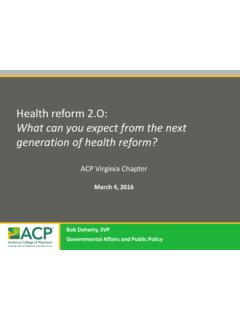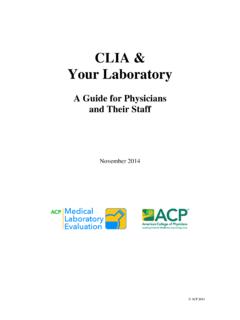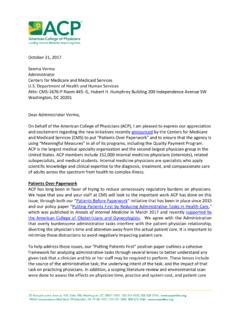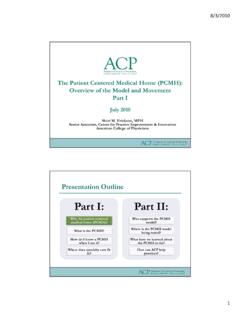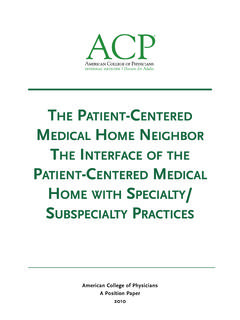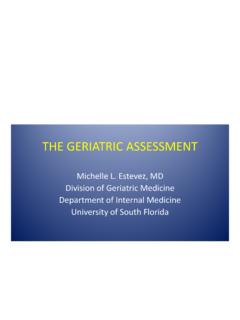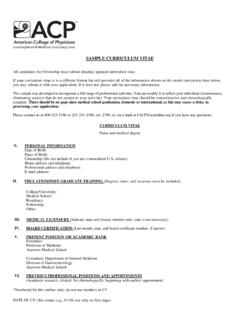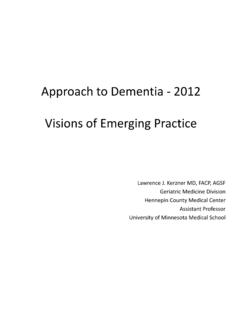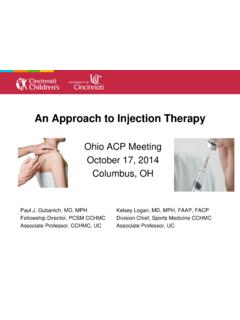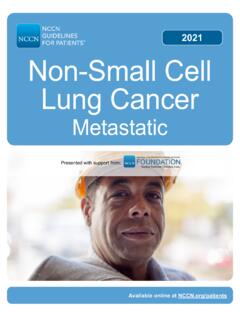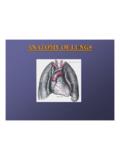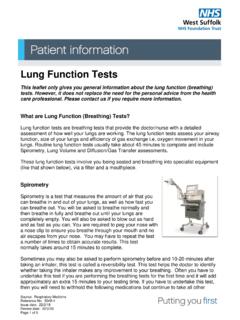Transcription of INTERPRETATION OF PULMONARY FUNCTION TESTS (PFTS)
1 INTERPRETATION OF PULMONARY FUNCTION TESTS (PFTS)Anna Neumeier, MDAssistant Professor, Department of PULMONARY Sciences and Critical Care MedicineACPF ebruary 2020 LEARNING the clinical indications for PULMONARY FUNCTION the physiology of the core PULMONARY FUNCTION TESTS : spirometry, lung volumes and an organized approach to interpreting PULMONARY FUNCTION obstructive, restrictive, mixed obstructive-restrictive and PULMONARY vascular patterns of abnormalities on PULMONARY FUNCTION FOR PFTS Evaluation of patients presenting with dyspnea Evaluating disease severity and monitoring response to treatment Determine fitness for surgery *thoracic surgery/lung resectionPFTS: AVAILABLE MEASURES Spirometry Airflow (how much air, how fast) (Static) Lung volumes Volume (how much air) Diffusing Capacity/DLCO Gas exchange (how effective) Other testing: Airway responsiveness Respiratory muscle strength testing Compliance of the lungsA PHYSIOLOGY REFRESHER:LUNG VOLUMES AND CAPACITIESAl-Askhar.
2 Cleveland Clinic Journal of Medicine. 2003Al-Askhar. Cleveland Clinic Journal of Medicine. 2003AN APPROACH TO PFT INTERPRETATIONSTEP 1: CONFIRM PATIENT DEMOGRAPHIC DATADEFINING NORMAL AND ABNORMAL VALUES INTERPRETATION involves comparison of the patient s values with reference values (Crapo Hsu, NHANES III, GLI) Dependent on age, sex, race and ethnicity, height African Americans have values that are 12% lower than Caucasians Threshold for Normal 80-120% predicted age-adjusted LLN (lower limits of normal)DEFINING OBSTRUCTION WITH FEV1/FVC RATIO:FIXED CUT-OFF VS. AGE-ADJUSTED LLNSTEP II: IS THE TEST OF ADEQUATE QUALITY?Acceptability andReproducibilityACCEPTABILITYFree from artifacts (cough, glottic closure)1 Free from leaks2 Good start3 Good Effort4 Examine the flow volume loop and the flow time acceptable maneuvers with at least 2 that are repeatable within of each other ( if FVC<1L) III: FLOW VOLUME LOOPSO bstructive DiseaseRestrictive DiseaseExtrathoracic airflow obstructionFixed airflow obstructionSTEP IV.
3 INTERPRET THE PFTS WITH A SYSTEMATIC APPROACHR ecognize the pattern and classify the severity of abnormalityPATTERNS OF DISEASE WITH PFTS Asthma COPD (emphysema, chronic bronchitis) Bronchiolitis/BronchiectasisObstructiveF EV1/FVC < (or <LLN) Interstitial lung disease Neuromuscular weakness Pleural disease Chest wall deformities ObesityRestrictiveFEV1/FVC reduced with low lung volumes* Both obstructive and restrictive elementsMixedObstructive PatternRestrictive PatternForced Vital Capacity (FVC)Decreased or normalDecreasedForced Expiratory Volume in 1 second (FEV1)DecreasedDecreased or normalFEV1/FVC ratioDecreasedNormalTotal Lung CapacityNormal or IncreasedDecreasedAl-Askhar. Cleveland Clinic Journal of Medicine. 2003 Step 1: Is there obstruction?Step 2: how severe is the obstruction?Step 4: Interpret lung volumesFull lung volumes are necessaryto assess whether restriction is presentStep 3: Is there response to bronchodilator?
4 Look at additional supplemental testing (DLCO, walk testing, bronchoprovocation)BRONCHODILATOR RESPONSE Improvement in FEV1 or FVC by 12% and 200cc Normalization of spirometry after bronchodilator supports the diagnosis of asthma The lack of BD response does not preclude a clinical response to bronchodilator therapyCASESCASE 1:A 29 y/o woman presents to your clinic with episodes of shortness of breath, chest tightness and wheezing during the springtime. You interpret her PFTs as: spirometry and lung obstructive restrictive patternAl-Askhar. Cleveland Clinic Journal of Medicine. 2003 CASE 1:A 29 y/o woman presents to your clinic with episodes of shortness of breath, chest tightness and wheezing during the spring time. You interpret her PFTs as: spirometry and lung obstructive restrictive patternNormal-no obstructionNormalNormalCASE 1 CONTINUED:Based on these lung FUNCTION TESTS , your suspicion that this patient has asthma , normal lung FUNCTION test rules out , her clinical history is suggestive and many patients with asthma have normal spirometry can t tell as a bronchodilator response was not assessedPFTS TO EVALUATE FOR ASTHMA Spirometry both pre-and post-bronchodilator Bronchodilator response supports diagnosis Normal spirometry does not excludea diagnosis of asthma Additional steps to assess for asthma: Bronchoprovocation testing (methacholine challenge) High-negative predictive value Empiric therapy Evaluation for asthma mimickers and look at flow volume loopCASE 2: A 67 Y/O MAN WITH COUGHCASE 2:You interpret his PFTs as: spirometry and lung obstructive restrictive patternCASE 2.
5 A 67 Y/O MAN WITH COUGHAl-Askhar. Cleveland Clinic Journal of Medicine. 2003 CASE 2:You interpret his PFTs as: spirometry and lung obstructive restrictive patternCASE 2 CONTINUED:All of the following conditions could be causes of his restrictive lung disease lung 2: A 67 Y/O MAN WITH COUGHCASE 2 CONTINUED:All of the following conditions could be causes of his restrictive lung disease lung VOLUMES-PATTERNS TO DIFFERENTIATE RESTRICTIVE DISEASEC ause of RestrictionPattern of lung volume abnormalityIntrinsic Lung Disease (interstitial lung disease, PULMONARY fibrosis)Low VC and low RVNeuromuscular DiseaseLow VC and high RVChest wall restriction (kyphoscoliosis)Low VC and low RVObesityLow FRC and low ERVCASE 3: A 77 Y/O MAN WITH DYSPNEA AND HYPOXEMIACASE 3 You interpret these PFTs spirometry and lung obstructive restrictive patternCASE 3: A 77 Y/O MAN WITH DYSPNEA AND HYPOXEMIAS everity of Airflow Obstruction.
6 FEV1 >80%-mildFEV1 50-80%-moderateFEV1 30-50% severeFEV1 <30% very severeCASE 3 You interpret these PFTs spirometry and lung obstructive restrictive patternLUNG VOLUMES: HYPERINFLATION AND AIR TRAPPINGH yperinflation= TLC>120%Air trapping with RV>140%CASE 4 A 76 y/o man presents with hypoxemia, you order PFTs which show:CASE 4 The PFTs spirometry and lung obstructive restrictive patternCASE 4 The PFTs spirometry and lung obstructive restrictive patternSTEP IV: ADDITIONAL TESTS :DLCOBRONCHOPROVOCATIONWALK TESTINGMEASURING GAS EXCHANGE: DLCOT ransfer of CO from alveoli to blood is diffusion limited:CO binds hemoglobin 210 times more efficiently than O2 and normally very low concentration in blood Thus, limited by surface area, membrane thickness & blood flow/HbUSE OF DLCO Restrictive Disease Low-intrinsic disease (parenchymal lung disease) Normal-extraparenchymal causes of restriction (obesity, neuromuscular disease, chest wall limitations) Obstructive Disease Low-emphysema Normal-asthma Isolated reduction in DLCO--> raises possibility of PULMONARY vascular diseaseCAUSES OF REDUCED DLCOD ecreased surface area-EmphysemaIncreased membrane thickness-FibrosisDecreased PULMONARY blood volumeAIRWAY RESPONSIVENESS Methacholine Challenge Obtain baseline FEV1 Administer bronchoconstrictive agent, methacholine, at incremental doses until FEV1 drops by 20% or reach maximal dose (16mg/ml)
7 Nebulize methacholine x2 min each dose then measure FEV1 at 30 and 90 sec after PC20 <4mg/ml consistent with asthma (<1mg/ml is severe) PC20 >16mg/ml does not have asthmaATS Guidelines, July 1999 EXERCISE CAPACITY TESTING, THE 6 MWTSIX MINUTE WALK TEST Measures exercise capacity NOT oxygen titration Used for: PULMONARY rehab PULMONARY hypertension response to advanced therapies Prognostication in IPF BODE index If you want to determine if your patient needs oxygen with exercise, order an oxygen titration studySUMMARYPFTs are valuable TESTS for evaluating symptoms of dyspnea1 Approach INTERPRETATION with a systematic approach2 PFTs provide a pattern of physiologic impairment but do not make a diagnosis3 QUESTIONS/ ADDITIONAL PRACTICE
